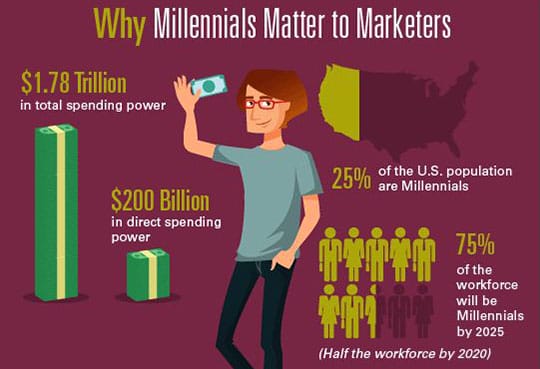The new buzz word “Millennials” is taking the digital world by storm. What does it mean anyway?
The word Millennial is used to refer to those individuals who were in early teens or tweens at the start of the new millennium (the year 2000). This generation comprises the major chunk of the working population in today’s time. In essence, most of the products and services are built around these Millennials and makes up the majority of business for big and small enterprises.
When the trade and innovation are centered around a specific section of mankind, your marketing strategies need a facelift to cater to this particularly important segment. Here are some strategies to get started:
1. Build an Appealing and User-Friendly Platform

The Internet is an ever-expanding marketplace, if you fail to provide your audience an attractive and more importantly, an easy platform to engage with, they will bounce off to your competitor’s website or application.
- Images, infographics, and videos increase the aesthetics of your website in addition to conveying your message more easily. Use high-quality stock photos and a professional expert to make infographics and videos.
- When building a website, take care of the mobile and tablet user base. Your content must be able to flow freely and adapt to the screen size and resolution across different platforms. Use predesigned themes and templates which offer a responsive design with amazing quality.
- The platform must be simple and easy to use. Employ intuitive features like drop-down menu and buttons instead of linked text. Avoid technical language. Use a simple and alluring copy of CTA.
2. Enticing and Authentic Content

According to a Telegraph report, an average adult spent more than 20 hours online a week in 2015, and the trend seems to skyrocket in the future. Millennials are seeking content-driven media, for knowledge and enlightenment. They’re also sharing, liking, tweeting and commenting without hesitation to impart this knowledge to a greater online community. Forbes came up with interesting findings of the online behavior of millennials:
- 33% review blogs before making a purchase. Make as much relevant content as possible related to your services and products to boost your conversion rate. Product explaining videos and reviews are highly recommended.
- 43% prefer authenticity over content. If your content seems redundant and “read (red) somewhere else before” it instantly breaks customer’s trust forever. Generate original content in-house or buy, instead of copying.
- 60% of millennials are loyal to specific brands. The sooner you build a relationship by engaging them with your content, the better is your brand reach.
3. Know your Audience and Personalize accordingly

Various studies have pointed out that millennials are fundamentally different from Gen X. Check this data from Rackspace and understand why it is important to relate to millennials.

To target more effectively you need to understand what sails their boats:
- Use behavior analytics to know your target user’s online habits. These factors may include gender, location, age, interests, past buying decisions and so on
- Based on the above-mentioned habits, create discreet profiles for different types of users. DO NOT add the same user in two different profiles.
- Create personalized marketing campaigns with unique content for each profile. It includes targeted PPC ads, Emails, organic search results, etc.
- Again use data science to decide the best time to shoot marketing campaign. Review and analyze the results to check what worked for your campaign and where it lagged. Improve your campaign in the next cycle.
4. The Evergreen SEO

SEO was and is a very important feature for your online content. SEO is adopted to feature “as high as possible” in the search engine’s natural search results for a specific keyword.
Besides the PPC advertising campaign, it is the only way to engage with users for a desired product or service. Adopt the following procedure:
- Focus on a single keyword and build your content around it. Make it sound natural and relevant to the end-user. Use tools like Google keyword planner to find suitable keyword and phrases.
- Link your content to and from prominent pages. Huge backlink support works wonder for SEO. Check below, how important backlinks are for Google’s search ranking algorithm
- Fast loading of your page and minimize bounce rates. Apart from improving UX it also helps the “crawling” ability of Google’s spiders on your pages. Google employee John Mueller pointed out at a delay of over 2 seconds for Google bots to fetch a single URL which ultimately limited the display of a website’s pages in search results.

SEO is easy and complex at the same time. Learn SEO step by step to utilize it to the fullest.
5. Give Real-Time Solutions, Don’t Preach and Act Humble

Just compare these two scenarios.
You buy a product but face some problem in using it; you drop a mail to the company and get a reply after one day asking for further details. A conversation like this can run for weeks without solving the problem.
Now imagine that there is a chatbox, you cite your issue and get a reply within a minute and discuss the whole issue in real-time. You get an instructional video and your problem is solved!
Most of us would feel better in the second scenario because it saves A LOT of time, it builds trust and relation, and it encourages prompt participation.
While delivering content and solutions make sure to act humble and don’t start preaching with phrases like “you should”. In addition to sounding “advocating”, it gives an impression that you are not a professional. Instead, say “DO XYZ”.
6. Increase Reachability with Social media

Social media is one of the best mediums to engage with millennials and other potential customers. According to WeAreSocialSG, there are 2.6 billion active social media users, with Facebook accounting for 1.65 billion users. Leaving Social media from the ambit of your marketing campaign limits your online consumer reach drastically.
- Make pages for your business on networks like Facebook, Google+, Twitter, LinkedIn, Pinterest, etc.
- Engage with Millennials “in person” and build a strong following. Post regular updates and link your pages and blogs in those updates.
- Use remarketing ads to target customers who have shown interest in “your type of business” in the past. It is much cheaper than a PPC campaign and shows significant ROI.
- Use paid advertising to “boost” your business. Make sure to target the right customer.
7. Build trust by Reviews and Customer Experience

Testimonials and customer response is a VERY effective way to build trust and reliability for your brand. Though you must aim for perfect reviews but sometimes a dissatisfied customer is inevitable.
- It is known that 88% of consumers trust online reviews as much as personal recommendations.
- Nearly 9 into consumers read online reviews to determine the quality of a local business.
- 85% of consumers read up to 10 reviews before making a decision.
- Prompt consistent users (but not too much) to rate your business on platforms such as Google, product listing services and social media.
- Send predesigned feedback forms on emails to satisfied customers.
- Aim for building a relationship instead of serving small time goals like purchasing specific products.
Conclusion:

While the above strategies are very important to drive a campaign aimed at Millennials, make sure you don’t fall for these very common digital marketing mistakes. Instead of helping your marketing efforts, it can ruin your business’ reputation by unfathomable amounts!
This article is written by Amy Porras. She is a lead Digital Marketing Strategist. She has led online marketing programs in Web Design, Web Development, Search Engine Optimization, Pay per Click Advertising and Online Marketing Campaigns, Social Media Marketing Strategy and Online PR for B2B professional services companies. Follow her on Google+.
 This article is written by Amy Porras. She is a lead Digital Marketing Strategist. She has led online marketing programs in Web Design, Web Development, Search Engine Optimization, Pay per Click Advertising and Online Marketing Campaigns, Social Media Marketing Strategy and Online PR for B2B professional services companies. Follow her on
This article is written by Amy Porras. She is a lead Digital Marketing Strategist. She has led online marketing programs in Web Design, Web Development, Search Engine Optimization, Pay per Click Advertising and Online Marketing Campaigns, Social Media Marketing Strategy and Online PR for B2B professional services companies. Follow her on 


